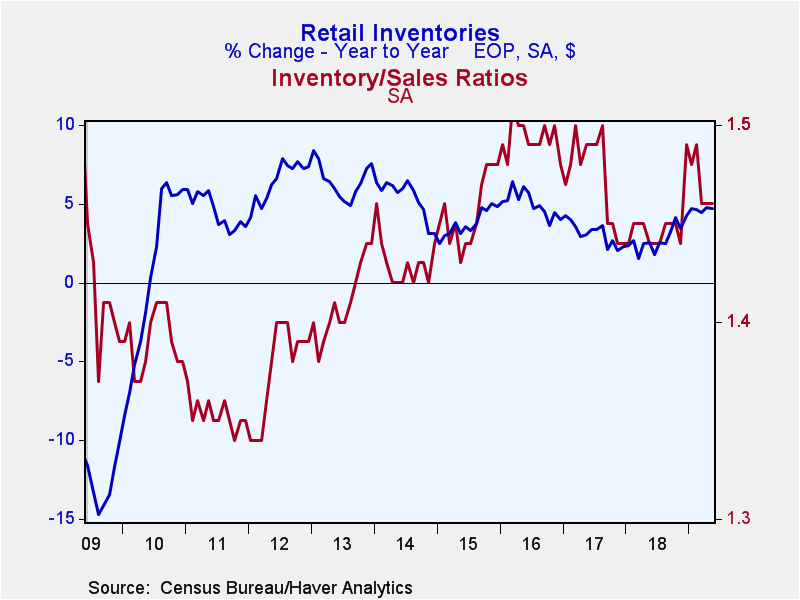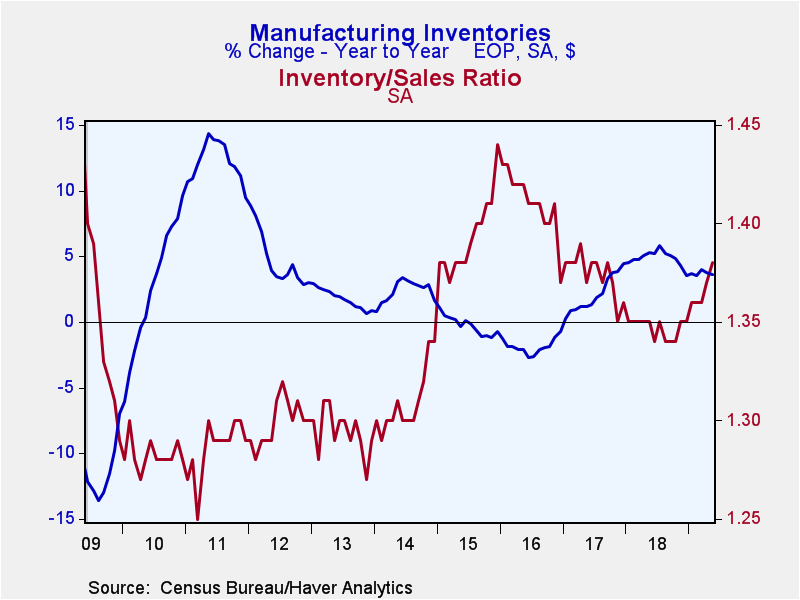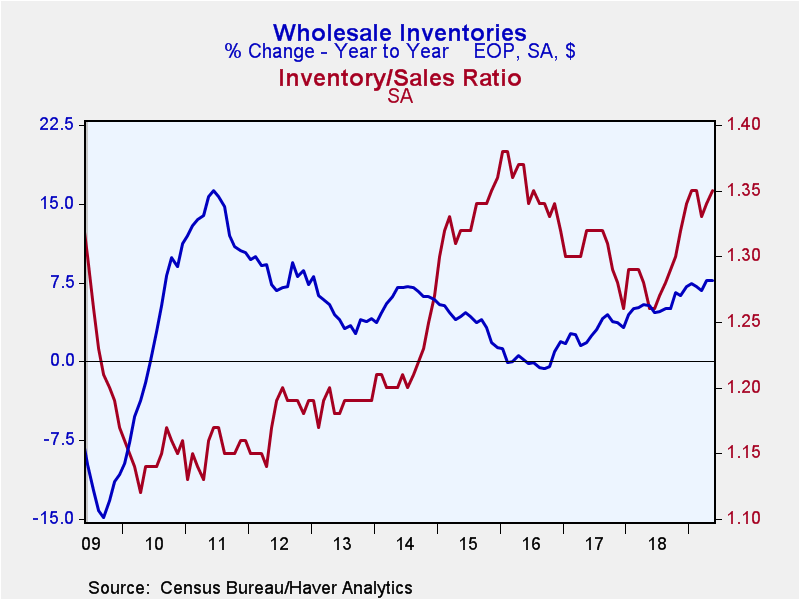 Global| Jul 16 2019
Global| Jul 16 2019U.S. Business Inventories & Sales Increase
by:Tom Moeller
|in:Economy in Brief
Summary
Total business inventories rose 0.3% (5.3% y/y) during May following an unrevised 0.5% April gain. Total business sales rose 0.2% (1.5% y/y) following an unrevised 0.2% decline. The inventory-to-sales (I/S) ratio held steady at an [...]
Total business inventories rose 0.3% (5.3% y/y) during May following an unrevised 0.5% April gain. Total business sales rose 0.2% (1.5% y/y) following an unrevised 0.2% decline. The inventory-to-sales (I/S) ratio held steady at an unrevised 1.39. Business inventory swings can have a meaningful impact on GDP. In 1Q'19 inventories added 0.6 percentage point to GDP growth following a 0.1 point addition to 4Q'18 growth.
Retail inventories increased 0.4% (4.7% y/y) in May after rising 0.6% during April. Auto inventories, which comprise roughly 35% of retail inventories, grew 0.7% (7.7% y/y). Non-auto retail inventories rose 0.3% (3.0% y/y). General merchandise inventories, the second largest sector fell 0.4% (-0.0% y/y). Department store inventories, a subset of general merchandise, moved 0.3% lower (-8.4% y/y) as clothing & accessory store inventories ticked 0.1% higher (0.8% y/y). Factory sector inventories gained 0.2% (3.6% y/y). As reported last week, wholesale inventories rose 0.4% (7.7% y/y).
Retail sales increased 0.3% in May (2.7% y/y, with non-auto sales growing 0.2% (2.6% y/y). Wholesale sector sales edged 0.1% higher (0.4% y/y), while shipments from the factory sector also rose 0.1% (1.4% y/y).
The inventory-to-sales ratio in the retail sector was unchanged at 1.46. The non-auto I/S ratio also was stable at 1.20, above the historic low of 1.17 reached in November 2018 (data goes back to 1967). The wholesale and factory sector I/S ratios edged up to 1.35 and 1.38 respectively.
The manufacturing and trade data are in Haver's USECON database.
| Manufacturing & Trade | May | Apr | Mar | May Y/Y | 2018 | 2017 | 2016 |
|---|---|---|---|---|---|---|---|
| Business Inventories (% chg) | 0.3 | 0.5 | 0.0 | 5.3 | 4.9 | 3.4 | 1.7 |
| Retail | 0.4 | 0.6 | -0.4 | 4.7 | 4.2 | 2.4 | 4.0 |
| Retail excl. Motor Vehicles | 0.3 | 0.5 | -0.2 | 3.0 | 1.7 | 2.0 | 2.0 |
| Merchant Wholesalers | 0.4 | 0.8 | -0.0 | 7.7 | 7.1 | 3.3 | 1.9 |
| Manufacturing | 0.2 | 0.2 | 0.4 | 3.6 | 3.5 | 4.5 | -0.7 |
| Business Sales (% chg) | |||||||
| Total | 0.2 | -0.2 | 1.3 | 1.5 | 6.1 | 5.4 | -0.8 |
| Retail | 0.3 | 0.3 | 2.0 | 2.7 | 4.6 | 4.5 | 2.4 |
| Retail excl. Motor Vehicles | 0.2 | 0.5 | 1.5 | 2.6 | 5.3 | 4.8 | 1.9 |
| Merchant Wholesalers | 0.1 | -0.4 | 1.8 | 0.4 | 6.5 | 6.7 | -1.3 |
| Manufacturing | 0.1 | -0.6 | 0.2 | 1.4 | 6.9 | 5.0 | -3.2 |
| I/S Ratio | |||||||
| Total | 1.39 | 1.39 | 1.38 | 1.34 | 1.36 | 1.38 | 1.42 |
| Retail | 1.46 | 1.46 | 1.46 | 1.44 | 1.45 | 1.47 | 1.49 |
| Retail excl. Motor Vehicles | 1.20 | 1.20 | 1.20 | 1.19 | 1.20 | 1.24 | 1.28 |
| Merchant Wholesalers | 1.35 | 1.34 | 1.33 | 1.26 | 1.29 | 1.30 | 1.35 |
| Manufacturing | 1.38 | 1.37 | 1.36 | 1.35 | 1.35 | 1.37 | 1.41 |
Tom Moeller
AuthorMore in Author Profile »Prior to joining Haver Analytics in 2000, Mr. Moeller worked as the Economist at Chancellor Capital Management from 1985 to 1999. There, he developed comprehensive economic forecasts and interpreted economic data for equity and fixed income portfolio managers. Also at Chancellor, Mr. Moeller worked as an equity analyst and was responsible for researching and rating companies in the economically sensitive automobile and housing industries for investment in Chancellor’s equity portfolio. Prior to joining Chancellor, Mr. Moeller was an Economist at Citibank from 1979 to 1984. He also analyzed pricing behavior in the metals industry for the Council on Wage and Price Stability in Washington, D.C. In 1999, Mr. Moeller received the award for most accurate forecast from the Forecasters' Club of New York. From 1990 to 1992 he was President of the New York Association for Business Economists. Mr. Moeller earned an M.B.A. in Finance from Fordham University, where he graduated in 1987. He holds a Bachelor of Arts in Economics from George Washington University.










